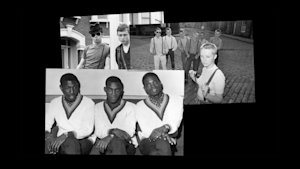
Standard skinhead attire included army boots, braces, jeans and Harrington jackets; while hair was kept short regardless of gender.
Some corners of skinhead culture might be more readily associated with racism and fascism in the present, but it wasn’t always that way. The subculture started out as something quite the opposite – a movement built on cultural exchange, a melding of heritage and an acceptance and appreciation of people’s differences.
It was in the late ‘60s that skinheads first emerged from working-class neighbourhoods and inner cities around the UK. Recognisable for their army boots, braces, straight-leg jeans and button-down shirts, they mixed together mod sounds and styles with those of the rude boys. The latter was another vibrant subculture that sprang up in Jamaica and the West Indies, which was imported to Britain by some of the hundreds of thousands of migrants who arrived from those countries in the ‘50s and ‘60s. Though rude boys had originated in the poorer areas in the Caribbean, they were sharp dressers. They often wore pork pie hats at an angle, and a knife-edge crease in their trousers. Both subcultures embraced their blue-collar status with pride, with rude boy style in particular hinting at aspiration and ambition.
Skinheads in smart shirts and cardigans dance to reggae music.
Because of the nature of the movements – and the exchange of cultures at the heart of them – the music commonly associated with skinheads was richly varied. Among the most recognisable artists were Jamaican acts like legendary ska, reggae, and rocksteady singer-songwriter Desmond Dekker, and reggae trio The Pioneers. Later on, punk artists like Angelic Upstarts and Sham 69 flew the flag for the accepting side of skinhead culture, performing at concerts organised by Rock Against Racism in the late ‘70s.
A movement built on cultural exchange a melding of heritage and an acceptance and appreciation of people's differences.
Connections with far-right activists have tainted the skinhead identity since its emergence, but organisations like Skinheads Against Racial Prejudice (SHARP), founded in 1986 in New York, hope to reclaim the multicultural identity of the original movement. They continue to confront the white supremacist faction of the subculture today.

Desmond Dekker was a rude boy icon both in Jamaica and overseas. Tracks like 'Rude Boy Train' and 'Rudie Got Soul' spoke directly to members of the subculture.


